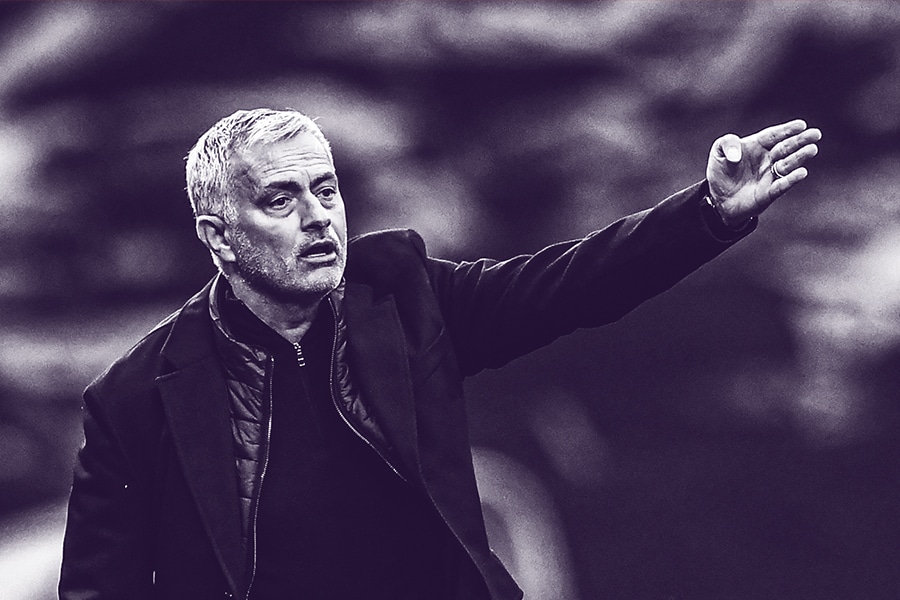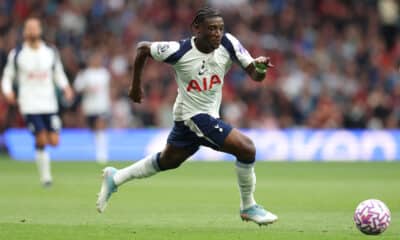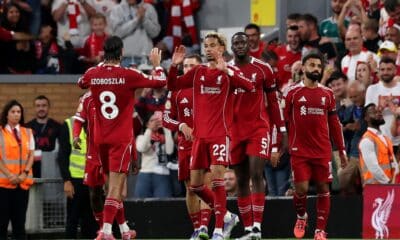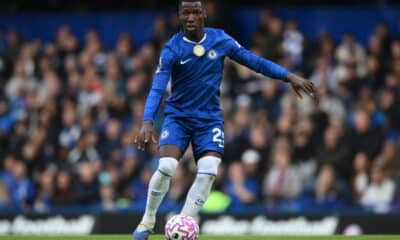
This article was inspired by Michael Cox’s recent article on The Athletic (requires subscription), where he named three games where key tactical formation changes, with the use of substitutions, helped turn Premier League matches. The examples mentioned included Harry Redknapp, John Gregory and Roberto Mancini. However, undoubtedly the best ever Premier League manager for turning games from the bench is José Mourinho.
After a 2-0 victory for Tottenham against Manchester City this past weekend by playing in a low block, many are hailing a “Mourinho masterclass ™ but the Portuguese coach was an outstanding attacking shapeshifter at Chelsea, in his first spell in particular. The coach would regularly throw on extra attackers and withdrew defenders to turn drawing or losing positions into wins. Six of the best examples of these alterations are below, both in league and cup matches.
Liverpool 2-3 Chelsea (2004-05)
In Mourinho’s first season in England, Chelsea reached the Carling Cup final against Liverpool at the Millennium Stadium in Cardiff. Just 35 seconds in the game, Liverpool were in front and Mourinho’s side had to chase the game.
The first change the coach made was to withdraw Jiri Jarosik in midfield at half time and bring on Eidur Gudjohnsen. Previously the Icelandic man was purely a striker but Mourinho moved him into his midfield three around that time so that his touch and creativity could come to the fore.
However, Liverpool were holding on to their lead after 73 minutes so Mourinho went for broke. Off went left-back, William Gallas and on came another striker in Mateja Kezman. This saw Ricardo Carvalho move from right centre back to the left of a back three. The shape switched from 4-3-3 to 3-3-4.
Five minutes later and Chelsea were level through Steven Gerrard’s own goal. As soon as the goal went in and before Mourinho had been sent to the stands for his celebration, the coach summoned Glen Johnson and immediately returned to a back four. That was a common move for the coach – go to a pure back three by introducing an extra striker, score a crucial goal, then readjust to ensure control of the game.
Postgame, the coach explained his celebration in a brilliant interview that summed up the intrigue and excitement his arrival brought to the Premier League.
“I’m not feeling the pressure. You cannot put pressure on me, no chance. I have read I have to prove a lot in English football. Sir Alex Ferguson is the only European champion in this country, nobody else, so I have to prove what?”
Chelsea 3-1 Fulham (2004-05)
As Chelsea looked to win their first Premier League title, Fulham came to Stamford Bridge under Chris Coleman and posed a major threat. With the score at 1-1 at half-time, Mourinho made a very positive change as he brought Arjen Robben on for defender Robert Huth and moved winger Damien Duff to left-back. The change worked a treat and Chelsea won 3-1 with the left sided combination of Duff and Robben together causing Moritz Volz absolute nightmares and the winner arrived from that flank.
That was far from the last time that Chris Coleman found himself in a tactical battle with Mourinho, saying: “The fact that Chelsea had to change formation three times is testament to how well we played. Mourinho changed it three or four times and it was like having a game of chess with him. He changed his team at halftime and switched formation twice in the second half. It was one of those games where we were trying to follow what he was doing to nullify it.”
Chelsea 5-1 Bolton (2005-06)
In Mourinho’s second season, he had signed Michael Essien, giving the coach one of the most multi-functional players of recent times. With William Gallas’ incredible versatility too, the coach could use these two extremely athletic players to change formations and still be able to cover wide spaces.
Against Bolton in October of that season, Chelsea trailed 1-0 to an organised Sam Allardyce side. At half-time, the coach withdrew Asier Del Horno at left-back and brought on Eidur Gudjohnsen to partner Didier Drogba in attack. The shape switch to a 3-3-4 formation as Chelsea went gung ho. What followed was three goals in the next 15 minutes before Mourinho withdrew Joe Cole for Paulo Ferreira and reverted to a back four.
Allardyce had found no answer to Chelsea’s midfield three with Gudjohnsen dropping off at times to make a diamond shape centrally with two wingers out on the touchlines. The game ended 5-1 after Bolton had a man sent off at 3-1.
The coach explained his team talk at the interval, saying: “It was a cool meeting at half-time where I had to explain with a lot of attention what we had to do. Sometimes when you are winning you have to be tough because they need to be shaken up but that was not the case. It was a question of bringing something different in tactical terms and what the opponent would not be ready for.”
Everton 2-3 Chelsea (2006-07)
Chelsea came into this game without the injured Petr Cech and John Terry. With David Moyes’ side using a 4-4-2 with Victor Anichebe and Andy Johnson up front, Everton were too much to handle for Khalid Boulahrouz. The Dutch centre back conceded a penalty on Anichebe and another clear foul on Johnson was missed by the referee, Mark Halsey.
Having started with a midfield diamond that day, featuring Arjen Robben as Didier Drogba’s strike partner in attack, Chelsea had found it difficult to break down Everton without much width in their play. Trailing 1-0 at half time, Mourinho changed to a 4-3-3, withdrawing right back Geremi and introducing Salomon Kalou, with Michael Essien moving to fullback.
Although Chelsea levelled just four minutes later (as Tim Howard pushed Michael Ballack’s freekick onto the post and then in off his own back), Everton went back in-front after 64 minutes as Joseph Yobo nodded in a corner.
Mourinho made a double change after 73 minutes, withdrawing a hopeless Boulahrouz for Wayne Bridge and bringing on Andrei Shevchenko for Arjen Robben. This saw the structure switch to a 3-5-2 with a crazy back three of Essien, Ricardo Carvalho and Ashley Cole, as Kalou and Bridge played wide. Shevchenko partnered Drogba in attack, and it was the Ukrainian’s header from Hilario’s long kick which was volleyed in by Drogba to seal a 3-2 win.
Moyes had done nothing to respond to Chelsea’s constant changes, only making substitutions in the 90th minute.
Chelsea 3-3 Tottenham (2006-07)
This game showed Mourinho at his adventurous best. Without John Terry and Claude Makelele, Mourinho started with a 4-3-3 shape featuring Lassana Diarra as the holding midfielder with Robben and Shevchenko starting either side of Drogba.
Martin Jol completely surprised Chelsea by using a midfield diamond, and Aaron Lennon as the number ten caused Diarra no end of problems, constantly pulling centre backs out of position to assist the young defensive midfielder.
After 36 minutes at Stamford Bridge, Spurs were 3-1 up. The first change made by Mourinho was just before the third goal at right-back, Paulo Ferreira was removed for Shaun Wright-Phillips with Diarra moving into a fullback role. However, the changes that really turned the tie came in the 57th and 64th minutes – first, Boulahrouz replaced Diarra, then Kalou replaced Ashley Cole.
After that point, Chelsea were set up in a 3-4-3 shape with Boulahrouz, Essien and Carvalho forming a back three, with Wright-Phillips and Robben wide, and Kalou joining Drogba and Shevchenko in a genuine three-striker shape. This saw two goals in the final 20 minutes with the leveller coming after 86 minutes as Drogba nodded down for Kalou to volley home inside the box.


Coleman Learns From Mourinho
In that first spell at Chelsea, one of the coaches who he enjoyed the best tactical battles with was Fulham’s Chris Coleman in the West London derby.
Aside from the above mentioned match when Mourinho used Damien Duff as a left-back, there was a 1-0 Fulham win where Coleman got the better of the Portuguese coach. Setting up in a surprise midfield diamond, The Cottagers were on top in the early stages (leading 1-0) and Mourinho had seen enough after 26 minutes and made a double tactical change. Off came Shaun Wright-Phillips and Joe Cole and on came Damien Duff and Didier Drogba as Chelsea moved from 4-3-3 to a midfield diamond of their own.
Although that change didn’t turn the result, it showed how decisive and proactive Mourinho was during that phase of his career. In a subsequent Chelsea-Fulham match, Mourinho’s side were level at 2-2 after 57 minutes so he threw on Didier Drogba in place of a central defender, went to a 3-3-4 shape, went in front and then took off a forward for a defender and went back to 4-3-3.
Mourinho explained, saying: “You play against very fast players like they have with only three defenders. We scored a goal, returned to our normal shape and after that fought hard against a very good side. This decision is only possible because I trust the players’ mentality.”
Coleman effusively praised Mourinho on numerous occasions explaining exactly why it was such a challenge coming up against him. The Welshman said:
“He’s a nightmare, always changing tactics and players. It was exhausting to be up against him and every time it felt as if I’d actually played in the game. Some call him arrogant but I say he’s confident and brilliant. I love his company and it was an education being up against him tactically in a match. I learned so much and he went out of his way to help me.”
Second Spell
In the coach’s second spell at Chelsea, these type of changes were a lot less common. The reason for this is not clear. Perhaps Mourinho was simply more risk averse after his spells at Inter Milan and Real Madrid. Or perhaps without incredible athletes like William Gallas and Michael Essien, those sort of risky changes were likely to backfire.
The Premier League arguably has much more tactically astute coaches now than between 2004 and 2007 so these changes may be better prayed upon these days. Back then, few opposition managers seemed to know how to respond before it was too late. Now, coaches would likely change shape immediately with the help of their analysts seeing the game from a wide-angle in the stands.
There were still a few examples of Mourinho’s bravery tactically though. A home game against Cardiff in the 2013-14 season saw left-back Ryan Bertrand taken off after an hour for Fernando Torres. A goal arrived and the coach promptly withdrew Samuel Eto’o for Cesar Azpilicueta and solidified things as was his modus operandi.
Chelsea 2-0 PSG (2013-14)
After 3-1 away loss to PSG in the first leg of the Champions League quarter-finals, Chelsea had a chance to turn things around in the second leg. A 2-0 victory followed but it was the coach’s incredibly positive and pre-planned changes to chase the game that were so impressive.
The first major alteration came after 66 minutes when Frank Lampard was taken off for an extra striker in Demba Ba with Oscar moving deeper into midfield. Then, with around 10 minutes to go, Fernando Torres was thrown on for Oscar as Chelsea went to essentially a 4-1-5 shape in search of a second goal.

Mourinho explained after the game that he had trained for those changes before the match so that all of the attacking players knew which spaces to occupy:
“We trained yesterday the three systems we used – the one from the start, the one without Lampard, and finally the one with Demba Ba and Fernando Torres. So the players knew what to do. The team that decided to defend was punished, and the team that gave everything deserved to go through to the semis.”
John Terry echoed that sentiment: “At 1-0 we always give ourselves a chance. We worked a lot all week on scenarios. Every scenario we had a gameplan and once again we got it right.”
As soon as the goal was scored in the 87th minute by Demba Ba, Mourinho sprinted to the celebrating Chelsea players to issue instructions on how to see out the game with so few defensive players to call upon and no substitutions left:
“I wasn’t celebrating. I ran to tell Fernando and Demba the changes we had to do, because still three minutes plus extra time, and playing the way we were playing it was too risky. I wanted Demba to play in front of the defenders, and Fernando to defend Maxwell.”
That game summed up the magic of Mourinho’s planning, pragmatism and adaptability. His team ended with Demba Ba playing as an extra central defender and Torres as an auxiliary fullback to defend Maxwell’s runs from left-back.
Mourinho v Lampard
On Sunday, Chelsea host Tottenham at Stamford Bridge with the two sides both near the top of the table in the Premier League. That game will prove a fascinating battle as Frank Lampard beat his former coach in both league matches last season by playing a 3-4-2-1 shape and asking questions that Mourinho did not have the answers to.
In the first meeting, in particular, the game was calling out for a tactical alteration in the first half but Mourinho either did not see the solution or was not proactive enough to make a first-half change. Ironically, Frank Lampard had a very similar situation one week later against Arsenal and decisively took off Emerson after 34 minutes for Jorginho and went from a 3-4-2-1 setup to a 4-3-3, turning a 1-0 deficit into a 2-1 win.
Read (requires subscription): Mourinho’s back five failed against one that was more natural and cohesive – https://theathletic.co.uk/1627084/2020/02/23/tottenham-chelsea-mourinho-back-three-negative/
Chelsea vs Tottenham kicks off at 6.30 pm South African time on Sunday.























